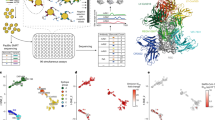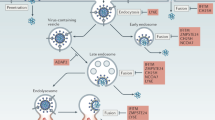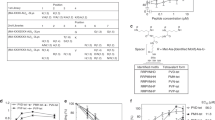Abstract
Manipulation of proteins is key in assessing their in vivo function. Although genetic ablation is straightforward, reversible and specific perturbation of protein function remains a challenge. Single domain antibody fragments, such as camelid-derived VHHs, can serve as inhibitors or activators of intracellular protein function, but functional testing of identified VHHs is laborious. To address this challenge, we have developed a lentiviral screening approach to identify VHHs that elicit a phenotype when expressed intracellularly. We identified 19 antiviral VHHs that protect human A549 cells from lethal infection with influenza A virus (IAV) or vesicular stomatitis virus (VSV), respectively. Both negative-sense RNA viruses are vulnerable to VHHs uniquely specific for their respective nucleoproteins. Antiviral VHHs prevented nuclear import of viral ribonucleoproteins or mRNA transcription, respectively, and may provide clues for novel antiviral reagents. In principle, the screening approach described here should be applicable to identify inhibitors of any pathogen or biological pathway.
This is a preview of subscription content, access via your institution
Access options
Subscribe to this journal
Receive 12 digital issues and online access to articles
$119.00 per year
only $9.92 per issue
Buy this article
- Purchase on Springer Link
- Instant access to full article PDF
Prices may be subject to local taxes which are calculated during checkout






Similar content being viewed by others
References
Mohr, S. E., Smith, J. A., Shamu, C. E., Neumuller, R. A. & Perrimon, N. RNAi screening comes of age: improved techniques and complementary approaches. Nature Rev. Mol. Cell Biol. 15, 591–600 (2014).
Kim, H. & Kim, J. S. A guide to genome engineering with programmable nucleases. Nature Rev. Genet. 15, 321–334 (2014).
Cohen, P. Guidelines for the effective use of chemical inhibitors of protein function to understand their roles in cell regulation. Biochem. J. 425, 53–54 (2010).
Doxsey, S. J., Brodsky, F. M., Blank, G. S. & Helenius, A. Inhibition of endocytosis by anti-clathrin antibodies. Cell 50, 453–463 (1987).
Gargano, N. & Cattaneo, A. Rescue of a neutralizing anti-viral antibody fragment from an intracellular polyclonal repertoire expressed in mammalian cells. FEBS Lett. 414, 537–540 (1997).
Hamers-Casterman, C. et al. Naturally occurring antibodies devoid of light chains. Nature 363, 446–448 (1993).
Muyldermans, S. Nanobodies: natural single-domain antibodies. Annu. Rev. Biochem. 82, 775–797 (2013).
Helma, J., Cardoso, M. C., Muyldermans, S. & Leonhardt, H. Nanobodies and recombinant binders in cell biology. J. Cell Biol. 209, 633–644 (2015).
Schmidt, F. I. et al. A single domain antibody fragment that recognizes the adaptor ASC defines the role of ASC domains in inflammasome assembly. J. Exp. Med. 213, 771–790 (2016).
Maass, D. R., Sepulveda, J., Pernthaner, A. & Shoemaker, C. B. Alpaca (Lama pacos) as a convenient source of recombinant camelid heavy chain antibodies (VHHs). J. Immunol. Methods 324, 13–25 (2007).
Ryckaert, S., Pardon, E., Steyaert, J. & Callewaert, N. Isolation of antigen-binding camelid heavy chain antibody fragments (nanobodies) from an immune library displayed on the surface of Pichia pastoris. J. Biotechnol. 145, 93–98 (2010).
Fridy, P. C. et al. A robust pipeline for rapid production of versatile nanobody repertoires. Nature Methods 11, 1253–1260 (2014).
Ashour, J. et al. Intracellular expression of camelid single-domain antibodies specific for influenza virus nucleoprotein uncovers distinct features of its nuclear localization. J. Virol. 89, 2792–2800 (2015).
Dougan, S. K. et al. Antigen-specific B-cell receptor sensitizes B cells to infection by influenza virus. Nature 503, 406–409 (2013).
Barrios-Rodiles, M. et al. High-throughput mapping of a dynamic signaling network in mammalian cells. Science 307, 1621–1625 (2005).
Guimaraes, C. P. et al. Site-specific C-terminal and internal loop labeling of proteins using sortase-mediated reactions. Nature Protoc. 8, 1787–1799 (2013).
Fodor, E. The RNA polymerase of influenza a virus: mechanisms of viral transcription and replication. Acta Virol. 57, 113–122 (2013).
Lyles, D. S. & Rupprecht, C. E. in Fields’ Virology (eds Fields, B. N. et al. 1364–1408 (Wolters Kluwer Health/Lippincott Williams & Wilkins, 2007).
Emerson, S. U. & Wagner, R. R. Dissociation and reconstitution of the transcriptase and template activities of vesicular stomatitis B and T virions. J. Virol. 10, 297–309 (1972).
Green, T. J. & Luo, M. Structure of the vesicular stomatitis virus nucleocapsid in complex with the nucleocapsid-binding domain of the small polymerase cofactor, P. Proc. Natl Acad. Sci. USA 106, 11713–11718 (2009).
Rahmeh, A. A. et al. Molecular architecture of the vesicular stomatitis virus RNA polymerase. Proc. Natl Acad. Sci. USA 107, 20075–20080 (2010).
Baltimore, D., Huang, A. S. & Stampfer, M. Ribonucleic acid synthesis of vesicular stomatitis virus, II. An RNA polymerase in the virion. Proc. Natl Acad. Sci. USA 66, 572–576 (1970).
Li, T. et al. Cell-penetrating anti-GFAP VHH and corresponding fluorescent fusion protein VHH-GFP spontaneously cross the blood–brain barrier and specifically recognize astrocytes: application to brain imaging. FASEB J. 26, 3969–3979 (2012).
Morin, B., Kranzusch, P. J., Rahmeh, A. A. & Whelan, S. P. The polymerase of negative-stranded RNA viruses. Curr. Opin. Virol. 3, 103–110 (2013).
Yewdell, J. W., Frank, E. & Gerhard, W. Expression of influenza A virus internal antigens on the surface of infected P815 cells. J. Immunol. 126, 1814–1819 (1981).
Sosa, B. A. et al. How lamina-associated polypeptide 1 (LAP1) activates torsin. eLife 3, e03239 (2014).
Meerbrey, K. L. et al. The pINDUCER lentiviral toolkit for inducible RNA interference in vitro and in vivo. Proc. Natl Acad. Sci. USA 108, 3665–3670 (2011).
Lefrancois, L. & Lyles, D. S. The interaction of antibody with the major surface glycoprotein of vesicular stomatitis virus. I. Analysis of neutralizing epitopes with monoclonal antibodies. Virology 121, 157–167 (1982).
Taipale, M. et al. Quantitative analysis of HSP90–client interactions reveals principles of substrate recognition. Cell 150, 987–1001 (2012).
Conrath, K. E. et al. Beta-lactamase inhibitors derived from single-domain antibody fragments elicited in the camelidae. Antimicrob. Agents Chemother. 45, 2807–2812 (2001).
Andersen, K. R., Leksa, N. C. & Schwartz, T. U. Optimized E. coli expression strain LOBSTR eliminates common contaminants from His-tag purification. Proteins 81, 1857–1861 (2013).
Green, T. J. et al. Access to RNA encapsidated in the nucleocapsid of vesicular stomatitis virus. J. Virol. 85, 2714–2722 (2011).
Kamentsky, L. et al. Improved structure, function and compatibility for CellProfiler: modular high-throughput image analysis software. Bioinformatics 27, 1179–1180 (2011).
Schickli, J. H. et al. Plasmid-only rescue of influenza A virus vaccine candidates. Phil Trans. R. Soc. Lond. B 356, 1965–1973 (2001).
Fodor, E. et al. Rescue of influenza A virus from recombinant DNA. J. Virol. 73, 9679–9682 (1999).
Pattnaik, A. K. & Wertz, G. W. Replication and amplification of defective interfering particle RNAs of vesicular stomatitis virus in cells expressing viral proteins from vectors containing cloned cDNAs. J. Virol. 64, 2948–2957 (1990).
Lehrach, H., Diamond, D., Wozney, J. M. & Boedtker, H. RNA molecular weight determinations by gel electrophoresis under denaturing conditions, a critical reexamination. Biochemistry 16, 4743–4751 (1977).
Morin, B., Rahmeh, A. A. & Whelan, S. P. Mechanism of RNA synthesis initiation by the vesicular stomatitis virus polymerase. EMBO J. 31, 1320–1329 (2012).
Cherry, S. et al. Genome-wide RNAi screen reveals a specific sensitivity of IRES-containing RNA viruses to host translation inhibition. Genes Dev. 19, 445–452 (2005).
Acknowledgements
The authors thank B. Bierie for help with lentiviral vectors, M. Taipale and G. Karras for help with LUMIER assays, S. Hulsey Stubbs for VSV-neutralizing antibodies, and T. DiCesare for help with illustrations. This work is supported by a National Institutes of Health Pioneer award to H.L.P. and additional funding from Fujifilm/MediVector. F.I.S. was supported by an Advanced Postdoc.Mobility Fellowship from the Swiss National Science Foundation (SNSF).
Author information
Authors and Affiliations
Contributions
F.I.S., L.H., B.M., R.B. and V.B. performed experiments and analysed the data. S.P.J.W. gave critical technical advice. F.I.S. and H.L.P. conceived the study and wrote the manuscript.
Corresponding author
Ethics declarations
Competing interests
The authors declare no competing financial interests.
Supplementary information
Supplementary information
Supplementary Figures 1-7 (PDF 866 kb)
Rights and permissions
About this article
Cite this article
Schmidt, F., Hanke, L., Morin, B. et al. Phenotypic lentivirus screens to identify functional single domain antibodies. Nat Microbiol 1, 16080 (2016). https://doi.org/10.1038/nmicrobiol.2016.80
Received:
Accepted:
Published:
DOI: https://doi.org/10.1038/nmicrobiol.2016.80
This article is cited by
-
In vivo detection of antigen-specific CD8+ T cells by immuno-positron emission tomography
Nature Methods (2020)
-
Antibodies and venom peptides: new modalities for ion channels
Nature Reviews Drug Discovery (2019)
-
Nanobody-based sandwich reporter system for living cell sensing influenza A virus infection
Scientific Reports (2019)
-
mRNA as novel technology for passive immunotherapy
Cellular and Molecular Life Sciences (2019)
-
Modulation von Proteinfunktion mit Alpaka-Nanobodies in lebenden Zellen
BIOspektrum (2017)



